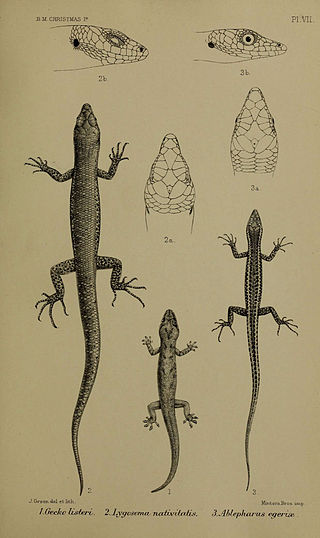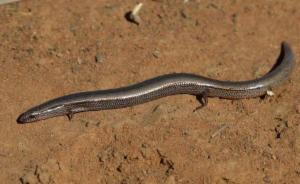
The pink-tongued skink is a species of lizard in the family Scincidae. It is endemic to Australia, where it is also called commonly the pink-tongued lizard. As suggested by these common names, its distinguishing characteristic is a pink tongue as opposed to the blue tongue of lizards of the closely related genus Tiliqua.

Menetia is a genus of skinks, lizards in the family Scincidae. The member species of the genus Menetia are endemic to Australia. They are ground-dwellers and live in open forests and open grasslands.

The western skink is a species of small, smooth-scaled lizard with relatively small limbs. It measures about 100 to 210 mm in total length. It is one of seven species of lizards in Canada. They spend much of their day basking in the sun. Their diet ranges widely, including spiders and beetles. Western skinks will bite if grasped and will flee if they feel threatened. It is a common but secretive species whose range extends from southern British Columbia and throughout Washington, Oregon, Nevada, Utah, Idaho, and Wyoming and into western Montana and northern Arizona and Missouri. They can also live in some areas of Texas It is widespread in northern California but primarily restricted to the coast in central and southern California. Found in a variety of habitats, this lizard is most common in early successional stages or open areas of late successional stages. Heavy brush and densely forested areas are generally avoided. Western skinks are found from sea level to at least 2,130 m (7,000 ft). This diurnal reptile is active during the warm seasons.

The black-headed python is a species of snake in the family Pythonidae. The species is endemic to Australia. There are no subspecies that are recognized as being valid.

Cunningham's spiny-tailed skink, also known commonly as Cunningham's skink, is a species of large skink, a lizard in the family Scincidae. The species is native to southeastern Australia.

The spiny-tailed monitor, also known as the Australian spiny-tailed monitor, the ridge-tailed monitor the Ackie dwarf monitor, and colloquially simply ackie monitor, is an Australian species of lizard belonging to the genus of monitor lizards (Varanus).

Lepidodactylus listeri, also known commonly as Lister's gecko or the Christmas Island chained gecko, is a species of gecko, a lizard in the family Gekkonidae, endemic to Christmas Island in the Indian Ocean. It is currently extinct in the wild.
The great desert skink, also known commonly as Kintore's egernia and by various other names including tjakura in various Aboriginal Australian languages, is a species of skink, a lizard in the family Scincidae. The species is native to the western half of Australia. It is a burrowing lizard and extremely social.

White's skink, also known commonly as White's rock skink, is a species of lizard in the skink family. It was first described in 1804 by French naturalist Bernard Germain de Lacépède. It is endemic to Australia.

Heteronotia binoei, known commonly as Bynoe's gecko, is a species of lizard in the family Gekkonidae, and is endemic to Australia. One of the continent's least-habitat-specific geckos, it occurs naturally across much of the country, and has also established in areas where it does not occur normally, such as urban Perth, Western Australia. It is dark brown to reddish-brown, depending on the colour of the ground upon which it lives, as well as irregular light bands with dark edges along its back.

Morethia boulengeri is a species of lizard in the family Scincidae. The species is endemic to Australia.

Tropidophorus grayi, commonly called the spiny waterside skink, Gray's keeled skink, Gray's water skink, and the Philippine spiny stream skink is a relatively abundant but secretive skink species, a lizard in the family Scincidae. The species is endemic to the Philippines.

Eulamprus quoyii, more commonly known as the eastern water skink, eastern water-skink, or golden water skink, is a viviparous species of diurnal skink. Eulamprus quoyii belongs to the family Scincidae and is considered a common garden animal in Australia. The skink is endemic to Australia and found only along the east coast of the country. It makes its home in creekside habitats along the east coast of Australia and in urban garden areas with high amounts of moisture. The species can be identified by the twin, long yellow stripes that run along its body from the top of the eye, as well as by several more specific character derived states. The pale yellow dorsolateral stripes are most likely where its common name, the golden water skink, is derived. Like other ectotherms, the skink can often be seen basking in the sun on rocky outcroppings in order to regulate its body temperature. Its diet mainly consists of both aquatic and terrestrial insects, tadpoles and small amounts of plant matter. The skink both hunts for food and scavenges when necessary and is considered an opportunistic feeder. It is prey to larger lizards, snakes, cats and birds and so will often be seen moving quickly into hiding when other organisms are present.

Saproscincus mustelinus, commonly known as the southern weasel skink or weasel shadeskink, is a small species of skink which is endemic to Australia.

Emoia atrocostata, commonly known as the littoral whiptail-skink, mangrove skink, or littoral skink, is a species of lizard in the family Scincidae. It inhabits mangroves, back-beach vegetation and rocky shorelines. It is semi-aquatic and forages in tidal pools.

The excitable delma is a species of lizard in the Pygopodidae family endemic to Australia. The lizard gets its name from its active and jumpy defense mechanism. It will erratically jump multiple times in succession, each jump pivoting its body in a different direction. D. tincta is a slender, long legless lizard that through evolution lost its limbs. It is found throughout Australia in a variety of habitats, and spends most of its time hiding. Due to its nocturnal nature, it is rare to spot in the wild. This legless lizard is small to moderate in size, with a tail that is three to four times its body length. The typical size of the excitable delma is 250 – 300 mm. This lizard is an insectivore and feeds on insects it finds when travelling through grass, logs, surface soil, and loose rocks. Like all pygopodids, the excitable delma is oviparous and only lays two eggs per clutch.
Menetia alanae, also known commonly as Alana's menetia and the Top End dwarf skink, is a species of lizard in the family Scincidae. The species is endemic to Australia.

Ctenotus leonhardii, known by the common names Leonhardi's ctenotus, Leonhardi's skink, and the common desert ctenotus, is a species of lizard in the subfamily Sphenomorphinae of the family Scincidae. The species is found in a range of arid and semi-arid regions throughout mainland Australia. Named after German anthropologist Moritz von Leonhardi in 1919, it belongs to the genus Ctenotus, one of the largest genera of lizards in Australia.

Lerista timida, the dwarf three-toed slider or wood mulch-slider, is a species of skink found in Australia. Other common names for the species include timid slider and dwarf burrowing skink. The skink is a member of the Lerista genus which are confined to continental Australia and are mostly a burrowing species of skink. The genus consists of consists elongated, smooth-scaled, Fossorial lizards that are specialized for life in the upper soils and dry leaf litter through which they slide using Lateral undulation as a form of locomotive action, giving rise to their nickname as sliders. They normally emerge of a night-time to hunt for small Invertebrates such as ants, termites and insects. If disturbed, they dive immediately into any loose substrate to avoid predation, this behavior leaves behind a distinctive disrupted wavy track that often found on sandy flats or dunes, roads and tracks.

Brachyurophis australis(coral snake) is a species of snake from the family Elapidae (common names - eastern shovel-nosed snake, coral snake, Australian coral snake) and is a species endemic to Australia. Its common name reflects its shovel nose specialisation.



















